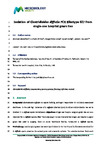Isolation of Clostridioides difficile PCR Ribotype 027 from single-use hospital gown ties
| dc.contributor.author | Waterfield, S | |
| dc.contributor.author | Ahmed, H | |
| dc.contributor.author | Jones, IA | |
| dc.contributor.author | Burky, R | |
| dc.contributor.author | joshi, lovleen | |
| dc.date.accessioned | 2022-04-25T09:37:51Z | |
| dc.date.issued | 2022-06-08 | |
| dc.identifier.issn | 0022-2615 | |
| dc.identifier.issn | 1473-5644 | |
| dc.identifier.other | ARTN 001550 | |
| dc.identifier.uri | http://hdl.handle.net/10026.1/19058 | |
| dc.description.abstract |
<jats:p> <jats:bold>Background.</jats:bold> <jats:italic> <jats:named-content content-type="species"> <jats:ext-link xmlns:xlink="http://www.w3.org/1999/xlink" ext-link-type="uri" xlink:href="http://doi.org/10.1601/nm.28959" xlink:type="simple">Clostridioides difficile</jats:ext-link> </jats:named-content> </jats:italic> is a spore-forming pathogen responsible for antibiotic-associated diarrhoea. In the USA high incidence of <jats:italic> <jats:named-content content-type="species"> <jats:ext-link xmlns:xlink="http://www.w3.org/1999/xlink" ext-link-type="uri" xlink:href="http://doi.org/10.1601/nm.28959" xlink:type="simple">C. difficile</jats:ext-link> </jats:named-content> </jats:italic> infection (CDI) in clinical environments has led to interest in <jats:italic> <jats:named-content content-type="species"> <jats:ext-link xmlns:xlink="http://www.w3.org/1999/xlink" ext-link-type="uri" xlink:href="http://doi.org/10.1601/nm.28959" xlink:type="simple">C. difficile</jats:ext-link> </jats:named-content> </jats:italic> spore transmission.</jats:p> <jats:p> <jats:bold>Hypothesis.</jats:bold> Single use hospital surgical gown ties act as a reservoir for <jats:italic> <jats:named-content content-type="species"> <jats:ext-link xmlns:xlink="http://www.w3.org/1999/xlink" ext-link-type="uri" xlink:href="http://doi.org/10.1601/nm.28959" xlink:type="simple">C. difficile</jats:ext-link> </jats:named-content> </jats:italic> spores.</jats:p> <jats:p> <jats:bold>Aim.</jats:bold> This study sought to examine whether single-use hospital surgical gown ties used in surgery, from an acute healthcare facility, harboured <jats:italic> <jats:named-content content-type="species"> <jats:ext-link xmlns:xlink="http://www.w3.org/1999/xlink" ext-link-type="uri" xlink:href="http://doi.org/10.1601/nm.28959" xlink:type="simple">C. difficile</jats:ext-link> </jats:named-content> </jats:italic> spores.</jats:p> <jats:p> <jats:bold>Methodology.</jats:bold> Used surgical gowns ties worn by clinicians in the healthcare facility were examined for <jats:italic> <jats:named-content content-type="species"> <jats:ext-link xmlns:xlink="http://www.w3.org/1999/xlink" ext-link-type="uri" xlink:href="http://doi.org/10.1601/nm.28959" xlink:type="simple">C. difficile</jats:ext-link> </jats:named-content> </jats:italic> spore presence via spread plate and anaerobic culture. The colonies isolated from each gown tie were subcultured on <jats:italic> <jats:named-content content-type="species"> <jats:ext-link xmlns:xlink="http://www.w3.org/1999/xlink" ext-link-type="uri" xlink:href="http://doi.org/10.1601/nm.28959" xlink:type="simple">C. difficile</jats:ext-link> </jats:named-content> </jats:italic> selective agar for phenotypic confirmation. Presumptive <jats:italic> <jats:named-content content-type="species"> <jats:ext-link xmlns:xlink="http://www.w3.org/1999/xlink" ext-link-type="uri" xlink:href="http://doi.org/10.1601/nm.28959" xlink:type="simple">C. difficile</jats:ext-link> </jats:named-content> </jats:italic> colonies were examined using <jats:italic> <jats:named-content content-type="species"> <jats:ext-link xmlns:xlink="http://www.w3.org/1999/xlink" ext-link-type="uri" xlink:href="http://doi.org/10.1601/nm.28959" xlink:type="simple">C. difficile</jats:ext-link> </jats:named-content> </jats:italic> Quik Check Complete, 16–23S PCR Ribotyping and MALDI-TOF analysis.</jats:p> <jats:p> <jats:bold>Results.</jats:bold> In total 17 suspected <jats:italic> <jats:named-content content-type="species"> <jats:ext-link xmlns:xlink="http://www.w3.org/1999/xlink" ext-link-type="uri" xlink:href="http://doi.org/10.1601/nm.28959" xlink:type="simple">C. difficile</jats:ext-link> </jats:named-content> </jats:italic> colonies were isolated from 15 gown ties via culture. <jats:italic> <jats:named-content content-type="species"> <jats:ext-link xmlns:xlink="http://www.w3.org/1999/xlink" ext-link-type="uri" xlink:href="http://doi.org/10.1601/nm.28959" xlink:type="simple">C. difficile</jats:ext-link> </jats:named-content> </jats:italic> Quik Check Complete found two isolates as possible <jats:italic> <jats:named-content content-type="species"> <jats:ext-link xmlns:xlink="http://www.w3.org/1999/xlink" ext-link-type="uri" xlink:href="http://doi.org/10.1601/nm.28959" xlink:type="simple">C. difficile</jats:ext-link> </jats:named-content> </jats:italic>. MALDI-TOF and PCR Ribotyping confirmed one isolate as <jats:italic> <jats:named-content content-type="species"> <jats:ext-link xmlns:xlink="http://www.w3.org/1999/xlink" ext-link-type="uri" xlink:href="http://doi.org/10.1601/nm.28959" xlink:type="simple">C. difficile</jats:ext-link> </jats:named-content> </jats:italic> PCR ribotype 027 associated with clinical outbreaks.</jats:p> <jats:p> <jats:bold>Discussion.</jats:bold> Our study revealed the presence of hypervirulent <jats:italic> <jats:named-content content-type="species"> <jats:ext-link xmlns:xlink="http://www.w3.org/1999/xlink" ext-link-type="uri" xlink:href="http://doi.org/10.1601/nm.28959" xlink:type="simple">C. difficile</jats:ext-link> </jats:named-content> </jats:italic> ribotype 027 spores on single-use gown ties. This highlights the potential of gown ties as a vector of spore transmission across clinical environments, especially when gowns are not worn appropriately.</jats:p> <jats:p> <jats:bold>Conclusions.</jats:bold> Appropriate compliance to infection control procedures by healthcare workers is essential to prevent spore dissemination across clinical facilities and reduce CDI rates.</jats:p> | |
| dc.format.medium | ||
| dc.language | en | |
| dc.language.iso | en | |
| dc.publisher | Microbiology Society | |
| dc.subject | Clostridioides difficile | |
| dc.subject | transmission | |
| dc.subject | spores | |
| dc.subject | gowns | |
| dc.subject | flooring | |
| dc.subject | infection control | |
| dc.title | Isolation of Clostridioides difficile PCR Ribotype 027 from single-use hospital gown ties | |
| dc.type | journal-article | |
| dc.type | Journal Article | |
| plymouth.author-url | https://www.webofscience.com/api/gateway?GWVersion=2&SrcApp=PARTNER_APP&SrcAuth=LinksAMR&KeyUT=WOS:000812256200007&DestLinkType=FullRecord&DestApp=ALL_WOS&UsrCustomerID=11bb513d99f797142bcfeffcc58ea008 | |
| plymouth.issue | 6 | |
| plymouth.volume | 71 | |
| plymouth.publication-status | Published | |
| plymouth.journal | Journal of Medical Microbiology | |
| dc.identifier.doi | 10.1099/jmm.0.001550 | |
| plymouth.organisational-group | /Plymouth | |
| plymouth.organisational-group | /Plymouth/Faculty of Health | |
| plymouth.organisational-group | /Plymouth/Faculty of Health/School of Biomedical Sciences | |
| plymouth.organisational-group | /Plymouth/REF 2021 Researchers by UoA | |
| plymouth.organisational-group | /Plymouth/REF 2021 Researchers by UoA/UoA01 Clinical Medicine | |
| plymouth.organisational-group | /Plymouth/Users by role | |
| plymouth.organisational-group | /Plymouth/Users by role/Academics | |
| dc.publisher.place | England | |
| dcterms.dateAccepted | 2022-04-20 | |
| dc.rights.embargodate | 2022-6-14 | |
| dc.identifier.eissn | 1473-5644 | |
| dc.rights.embargoperiod | Not known | |
| rioxxterms.versionofrecord | 10.1099/jmm.0.001550 | |
| rioxxterms.licenseref.uri | http://www.rioxx.net/licenses/all-rights-reserved | |
| rioxxterms.type | Journal Article/Review |


